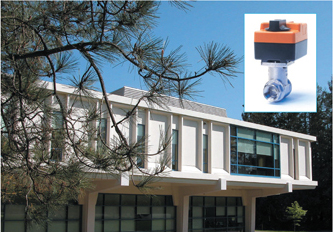Precision Control Plays Role in Sonoma State University Renovation

You don’t change a 30+ year old university library into what Pacific Gas and Electric Company calls northern California’s most energy efficient building without careful attention to detail.
Sonoma State University had high aspirations for converting the original Ruben Salazar library into a multi-use facility and was willing to go the distance to achieve their goal without a large increase in campus demand for peak power. Be assured, a project like this demands a lot of careful consideration, from selection of the 106 kW solar photovoltaic system to the valves and actuators that control water flow and damper operation in over 100 zones.
Precision Control Means Better Efficiency
Principal engineer, Tony Costa, and design engineer, Edmund Cancio, of Costa Engineers, Inc. were well aware of the campus goals and budget when selecting the characterized control valves and actuators that would be used on the VAV reheat coils, dampers, and chilled water cooling coils. The valves and actuators would play an important role in the system’s overall efficiency, as these VAVs and coils would enable the building to maintain 100% outdoor air and carefully maintain accurate flows to maintain comfort at the lowest possible pump speed.
It was very important, according to Costa, that they be able to carefully track flow through the coils. The operation of the variable frequency drives (VFD) on the heating and cooling systems is based on flow through the control valves. Costa knew from experience that Belimo’s Characterized Control Valves (CCV’s) were extremely accurate and they, along with direct connected actuators and DDC controls, would enable the university to continuously monitor every valve in the building and adjust pump flow rates based on valve position. Minimum required flow rate is attained when all zones are satisfied and no control valve is more than 90% open. It comes down to a well-known engineering fact: Cut flow in half and you’ll reduce pump horsepower by the cube. Costa Engineers was determined to make every horsepower count.
Ordinarily, an engineer might select globe valves for this type of application. However, the engineering firm had tried the CCVs shortly after they were introduced to the market in 1999 and subsequently realized they could get the same accurate control from this "ball-type" control valve at significantly less expense, size and weight – and with higher close-off capability.
This accuracy, says Tony Costa, is a function of two characteristics, both of which result in a linear heat output. First, actuators for the CCVs are direct-coupled, eliminating typical mechanical linkage, which may, over time, impede the repeatability of the valve. Second, the CCV has a wide variety of Cv values for each valve size. Multiple values will allow an engineer to easily size valves closer to the pipe size, resulting in less time and money spent on pipe reductions while still achieving accurate control. Costa was able to select the same CCV valve on several different coils and continually maintain the same pressure drop across the valve, which was absolutely critical in this application. Typical variations in pressure would cause other valves to hunt, resulting in less system accuracy. Simply put, improve the control range of the valve, and you’ll reduce overall energy consumption of the system.
The design of the Sonoma control system is a step above most others because of the precise control it allows over individual zones. Typically, system VFD’s react to an "average" in pressure change, rather than the individual position of each valve. However, at the Ruben Salazar building, operators know exactly which valve is at its worse case scenario and can drive the pumps to meet that particular condition without consuming unnecessary energy.
Recognition & Rebates
The control valves and damper actuators play an important role in a very expansive and complex system that incorporates 76 kWpAC (kilowatt peak AC output) solar powered energy, a unique direct/indirect evaporative cooling system, outdoor air economizers, and a stratified chilled water thermal storage system. According to Keith Marchando, Project Engineer at Sonoma, "There is not an installation quite like this, where all of these forms of energy conservation come together at this level." Fully operational since late 2002, the system continues to surpass the goals and expectations of the campus and the engineers involved. The building has been able to maintain an indoor temperature of 72 to 75°F without help from the chilled water system. It uses 42% less energy than what is required by California’s 1998 Title 24 Building Standard and Sonoma’s own observations indicate that the total system design has reduced peak load by almost 400 tons on the hottest days of summer. The Ruben Salazar project earned the University an ASHRAE Regional X Award in the category of "Institutional Building, Existing" and an Energy User News award for the "Best Education Facility Project." It has also caught the attention of The California Energy Commission and the Lawrence Berkeley National Laboratory, which has hired the Davis Energy Group to further study the performance of the building. Pacific Gas and Electric Company has also raised a toast to the Ruben Salazar building and Sonoma University the tune of $703,200.00 in rebates and incentives over the last 8 years for this and other energy efficient projects.

